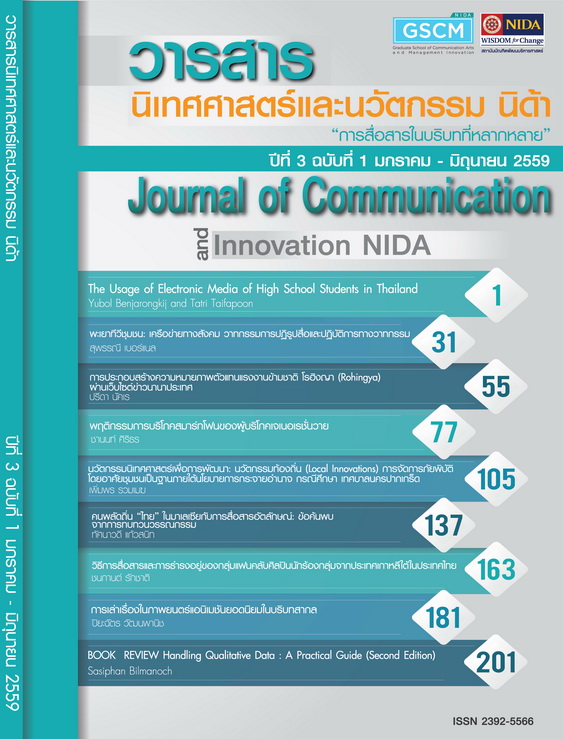The Usage of Electronic Media of High School Students in Thailand
Main Article Content
Abstract
The objectives of this research, “Usage of Electronic Media of High School Students in Thailand”, are 1) To explore electronic media access of secondary school students, 2) To study electronic media usage of secondary school students, and 3) To recommend creative media usage to support learning of secondary school students while corresponding to the educational policies of the Ministry of Education. The research uses a combination of methods: Survey research-cross sectional method and Focus group Method.
Findings
Media access and electronic media usage. Electronic media that most samples have access to are television and mobile phone. The activities that the samples do most often in their leisure time are watching television, using the Internet, cooking together with family, and using mobile phones. The samples are exposed to and have access to the most are televisions, the Internet, and mobile phones. They have very little exposure to educational television programs. Mother and father are the persons that most samples confined in, followed by friends, brothers and sisters, and teachers respectively. The samples have a low media literacy level. It is found that most samples still lack correct understanding of the behavioral norms of the Thai society.
Creative media suggestions to promote learning in secondary schools and which correspond to the educational policies of the Ministry of Education. It is found that the reason that makes secondary school students maintain incorrect attitudes toward the contents of media presentation is that they understand and believe that what the media present are values that should be followed. The society shows that it accepts the presented contents. What the media present is not reality, thus children form incorrect values according to media presentations. Good contents cannot reach children because of their presentation formats and the difficulties in accessing the channels.
The approach in developing media to promote children learning is that media producer should produce media that benefit children: make contents positive, use language correctly, insert teachings of integrity and correct values into the program, promote critical thinking in children, and make contents suitable for children’s current context. Producer should use interesting and diverse presentation methods.
Schools should use a curriculum that focuses on children’s ability to think critically for the children to be able to analyze media. There should be organizations and federations, which possess the authority to reward or punish media producer, to control media production. Children and parents should be involved in developing media, and a common media production goal should be established between different networks.
การวิจัยเรื่องนี้ มีวัตถุประสงค์ของการศึกษาวิจัย คือ 1) เพื่อสำรวจการเข้าถึงสื่ออิเล็กทรอนิกส์ของนักเรียนในระดับชั้นมัธยมศึกษา 2) เพื่อศึกษาสภาพการใช้สื่ออิเล็กทรอนิกส์ของนักเรียนในระดับชั้นมัธยมศึกษา และ 3) เพื่อเสนอแนะสื่อสร้างสรรค์เพื่อส่งเสริมการเรียนรู้ที่พึงประสงค์ในระดับชั้นมัธยมศึกษา ซึ่งสอดคล้องกับนโยบายการศึกษาของกระทรวงศึกษาธิการ โดยใช้ระเบียบวิธีวิจัยแบบผสมผสาน ใช้เทคนิคการวิจัยเชิงเชิงสำรวจ (Survey Research) ร่วมกับเทคนิคการสนทนากลุ่มผู้เชี่ยวชาญ (Focus Group)
ผลการวิจัย การเข้าถึงสื่อและการสภาพการใช้สื่ออิเล็กทรอนิกส์ กลุ่มตัวอย่างมีความสามารถในการเข้าถึงสื่ออิเล็กทรอนิกส์ประเภทเครื่องรับโทรทัศน์และโทรศัพท์เคลื่อนที่ได้มากที่สุด พฤติกรรมการทำกิจกรรมและการใช้สื่อในเวลาว่าง หรือเพื่อความบันเทิง ผลการวิจัยพบว่า กิจกรรมที่กลุ่มตัวอย่างมักจะทำในเวลาว่างและทำบ่อยครั้งมากที่สุด ได้แก่ การชมโทรทัศน์ การใช้อินเทอร์เน็ต การทำอาหารร่วมกันภายในครอบครัว และการใช้โทรศัพท์เคลื่อนที่ สื่ออิเล็กทรอนิกส์ ที่กลุ่มเป้าหมายเปิดรับและเข้าถึงมากที่สุด ได้แก่ โทรทัศน์ อินเทอร์เน็ต และโทรศัพท์เคลื่อนที่ กลุ่มตัวอย่างมีการเปิดรับรายการโทรทัศน์เพื่อการศึกษาน้อยมาก พ่อและ/หรือแม่ เป็นบุคคลที่กลุ่มตัวอย่างมักจะปรึกษาปัญหาเป็นอันดับแรก กลุ่มตัวอย่างมีความรู้เท่าทันสื่อในระดับค่อนข้างต่ำ สำหรับทัศนคติต่อการดำเนินชีวิตในด้านต่างๆ พบว่า กลุ่มตัวอย่างส่วนใหญ่ยังขาดความรู้เข้าใจที่ถูกต้อง เกี่ยวกับพฤติกรรมการดำเนินชีวิตตามบรรทัดฐานของสังคมไทยอยู่เป็นจำนวนมาก
ส่วนข้อเสนอแนะสื่อสร้างสรรค์เพื่อส่งเสริมการเรียนรู้ที่พึงประสงค์ในระดับชั้นมัธยมศึกษา ซึ่งสอดคล้องกับนโยบายการศึกษาของกระทรวงศึกษาธิการ พบว่า สาเหตุที่ทำให้นักเรียนระดับชั้นมัธยมศึกษามีทัศนคติที่ไม่ถูกต้องต่อการนำเสนอเนื้อหาของสื่อ คือ เด็กมีการรับรู้และเชื่อถือว่าสิ่งที่สื่อนำเสนอนั้นเป็นทัศนคติและค่านิยมที่ควรปฏิบัติตาม สังคมแสดงการยอมรับต่อเนื้อหาที่นำเสนอ สาระที่นำเสนอในสื่อไม่ได้อยู่ในโลกของความเป็นจริง จึงทำให้เด็กเกิดค่านิยมที่ผิดตามการนำเสนอของสื่อ และสื่อดีไม่สามารถเข้าถึงเด็กได้เพราะรูปแบบการนำเสนอ หรือช่องทางการสื่อสารที่เข้าถึงได้ยาก
แนวทางในการพัฒนาสื่อเพื่อส่งเสริมการเรียนรู้ของเด็กคือ ผู้ผลิตสื่อควรสร้างสรรค์สื่อที่มีประโยชน์ต่อเด็ก มีเนื้อหาทางบวก ใช้ภาษาถูกต้อง สอดแทรกการสอนจริยธรรมและค่านิยมที่ถูกต้อง สนับสนุนให้เด็กคิดเป็น และสอดคล้องกับบริบทของเด็กในปัจจุบัน วิธีการในการนำเสนอสื่อ ควรใช้รูปแบบที่น่าสนใจ และมีความหลากหลาย โรงเรียนควรมีการจัดการเรียนการสอนที่เน้นให้เด็กมีความสามารถในการคิดวิเคราะห์ เพื่อให้เด็กสามารถแยกแยะสื่อได้ และควรมีองค์กรและสภาวิชาชีพที่มีความรู้เพื่อควบคุมการผลิตสื่อ และสามารถให้คุณและโทษแก่ผู้ผลิตสื่อได้ ให้เด็กและผู้ปกครองได้มีส่วนร่วมในการพัฒนาสื่อ และควรมีการกำหนดเป้าหมายในการผลิตสื่อร่วมกันระหว่างเครือข่าย
Article Details
ข้อความและความเห็นในวารสารนิเทศศาสตร์และนวัตกรรม นิด้า เป็นของผู้เขียนแต่ละท่าน มิใช่ของคณะนิเทศศาสตร์และนวัตกรรมการจัดการ สถาบันบัณฑิตพัฒนบริหารศาสตร์


